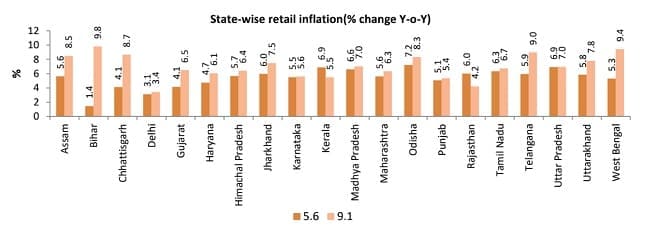There has been an easing in retail inflation in November’20, aided by the moderation in food inflation. Retail inflation for the month at 6.9% was in line with CARE Ratings forecast.
Despite the moderation, the inflation reading continues to be elevated and above the upper band of the RBI target range for retail inflation (6%), for the twelveth successive month.
There has been a buildup in price pressure at the wholesale level too. The wholesale inflation in November climbed to the highest level in nine months (to 1.6%).

Retail Inflation Movement
- The easing of the rate of growth in retail inflation in November can in part be also attributed the statistical (high) base effect (5.5% in November’19).
- The decline in retail inflation in November was not broadbased.
- Core inflation firmed up in November to the highest levels in over two year.
- Price pressure are higher in rural India. Rural inflation was higher than urban inflation in November and the gap between the two has widened to the highest level since March’20.
- Nearly all states have witnessed an increase in retail prices in November’20 v/s November’19. There has however been an easing in retail prices levels from October’20 across states.

Source: MOSPI
- Food prices (which have the highest weight in the CPI index at 45.86) witnessed the sharpest decline in the growth in price levels (by 1.3%) amongst the key component of the CPI in November’20 from October ’20. Food inflation nevertheless was notably higher than year ago levels by 8.8%
– Vegetable prices saw the sharpest decline in growth rates (by 6.9%) in November’20 v/s October’20. This decline can be attributed to the higher production reaching markets during the month. Despite the improvements were 16% higher than that in November’19 and can be attributed to the supply disruption consequrnt to the lockdown and unfavorable weather conditions (unseasonal rains) in the main producing regions of Maharashtra and Madhya Pradesh.
– Double digit price increases continued to be recorded most segments of the food basket in November’20 from that in November’19 – meat and fish (17%), eggs (20%),pulses and oil & fats (18% each) and spices (11%).
- Miscellaneous segment inflation at 6.94% in November, reversed the moderation of the previous month and rose by 0.6%. Price increases in the transport and communication and the personal care segments (by over 11% each) pushed up overall price levels in the segment.
- Hosuing inflation moderated marginally by 0.1% in November’20 from the previous month.
Core Inflation
Core inflation (which excludes the food & beverages and the fuel & light group having a combined weight of 52.7 in the CPI) inched up, albeit marginally, by 0.02% in November’20, taking it to an over two year high. The firming up of core inflation is reflective of the broad based nature of the prevailing price pressures.

Source: MOSPI
Rural and Urban Inflation
There has been a moderation in retail inflation in the rural as well as urban areas in November’20, with the decline in urban inflation being higher. Urban retail inflation dropped to a four months low during the month. This decline can in part be ascribed to a higher base (5.8% in November’19).
The gap between rural and urban inflation has been widening since the last three months and at 0.5% in November’20 it is the highest since March’20. This is indicative of the price pressures prevailing in rural India.

Statewise Inflation
The majority of states have witnessed an increase in the growth rate of retail prices in November’20 from November’19. Of the 21 states who have reported changes in retail inflation for November’20, only 2 states i.e. Rajasthan(-1.8%) and Kerala (-1.4%) have seen a decline in the growth rate of prices on a year-on-year basis. Price levels were relatively stable in Uttar Pradesh (y-o-y). Among the states, the sharpest increase in price levels has been in the case of Bihar at 8.5% in November’20 over November’19.
With the exception of Gujarat (0.1% increase) and Himachal Pradesh (1.1% increase), the growth in retail inflation has declined across states in November’20 from that in October’20.

Outlook
The supply side issues viz. in case of agricultural commodties could ease, albeit gradually, with the resumption of activity across regions. Also, the higher output,with increased crop productivity, coming into the markets could help cool prices of agricultural produce to an extent. At the same time, the firming of global commodity prices and the increase in logistics costs would put added pressure on price levels across segments. In addition there are concerns that the ongoing farmers agitation would impact prices of agricultural commodities.Despite the upside risk, the statistical high base effect over the next few months could lead to a moderation in inflation rate. We expect retail inflation to move towards 5.5% by March’21.

